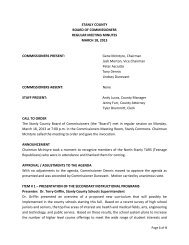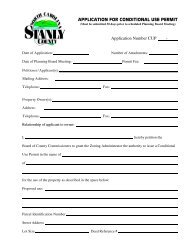Land Use Plan – 2002 - Stanly County, North Carolina
Land Use Plan – 2002 - Stanly County, North Carolina
Land Use Plan – 2002 - Stanly County, North Carolina
You also want an ePaper? Increase the reach of your titles
YUMPU automatically turns print PDFs into web optimized ePapers that Google loves.
STANLY COUNTY<br />
<strong>Stanly</strong> <strong>County</strong> is 399 square miles in area, ranking it as the 64th-largest of <strong>North</strong> <strong>Carolina</strong>’s 100<br />
counties. While most of <strong>Stanly</strong> <strong>County</strong>’s land area is used for either farming or is undeveloped<br />
forest land, the counties is also home to a number of communities including Albemarle, Badin,<br />
Locust, New London, Norwood, Oakboro, Red Cross, Richfield, and Stanfield (see Figure 1-1).<br />
With a 2000 population of 58,100, <strong>Stanly</strong> <strong>County</strong> ranks as the 42nd<strong>–</strong>largest county in <strong>North</strong><br />
<strong>Carolina</strong> according to the U.S. Census Bureau.<br />
The county is served by a number of major state and federal roadways that link the county to the<br />
adjoining region. Among these is NC 24/27, a major east-west roadway that links Albemarle,<br />
Locust, and Stanfield with Cabarrus and Mecklenburg Counties as well as the rest of the<br />
Charlotte metropolitan region. Another important roadway is U.S. 52, a north-south thoroughfare<br />
that links the central part of <strong>Stanly</strong> <strong>County</strong> with Salisbury and Interstate 85 to the north and U.S.<br />
74 in Wadeboro in Anson <strong>County</strong>.<br />
<strong>Land</strong> <strong>Use</strong> <strong>Plan</strong> Study Area<br />
History<br />
The <strong>Land</strong> <strong>Use</strong> <strong>Plan</strong> study area is indicated in Figure 1-2. The study area includes<br />
unincorporated areas of <strong>Stanly</strong> <strong>County</strong> outside of municipal extra-territorial jurisdictions, or ETJs.<br />
New London, Norwood, Locust, Oakboro, Richfield, and Stanfield have exercised ETJs. All<br />
totaled, the study area includes 174,360 acres of <strong>Stanly</strong> <strong>County</strong>’s 216,960 acres of land area, or<br />
80.3 percent of the county.<br />
<strong>Plan</strong>ning issues, however, do not stop at corporate boundaries. The <strong>Land</strong> <strong>Use</strong> <strong>Plan</strong> examines<br />
the planning and development goals of the municipalities of the county to ensure that long-range<br />
planning is coordinated and consistent.<br />
<strong>Stanly</strong> <strong>County</strong> has a rich and colorful natural and cultural history. <strong>Stanly</strong> <strong>County</strong> lies at the<br />
southwestern end of the Uwharrie Mountains, which at 500-million years of age are considered<br />
to be the oldest mountain range in <strong>North</strong> America. Evidence suggests human settlement dating<br />
back 10,000 years ago when small tribes of hunter-gatherers roamed the Piedmont region.<br />
Though the <strong>North</strong> <strong>Carolina</strong> Colony was established by the British crown in 1663, the <strong>Stanly</strong><br />
<strong>County</strong> region was generally uncolonized until the 1780s and 1790s, owing to its isolation<br />
provided by the Yadkin and Pee Dee Rivers. An area south of Norwood was the site of an<br />
American Revolutionary War confrontation, the Battle of Colson’s Ordinary, in July 1780.<br />
<strong>Stanly</strong> <strong>County</strong> was formed from the western portion of Montgomery <strong>County</strong> by the state<br />
legislature on January 11, 1841. The county is named for John <strong>Stanly</strong>, a colorful 19th-century<br />
theorist, orator, and statesman who served in the House of Commons, state legislature, and 7th<br />
and 11th U.S. Congresses. Albemarle, the county seat and largest city in <strong>Stanly</strong> <strong>County</strong>, was<br />
incorporated in 1857.<br />
As part of the process used to develop the <strong>Land</strong> <strong>Use</strong> <strong>Plan</strong>, a timeline of events shaping the<br />
history of <strong>Stanly</strong> <strong>County</strong> has been developed during the course of the public meeting process.<br />
The timeline is included in Appendix A to this report.<br />
<strong>Land</strong> <strong>Use</strong> <strong>Plan</strong> 1-3 6/02






